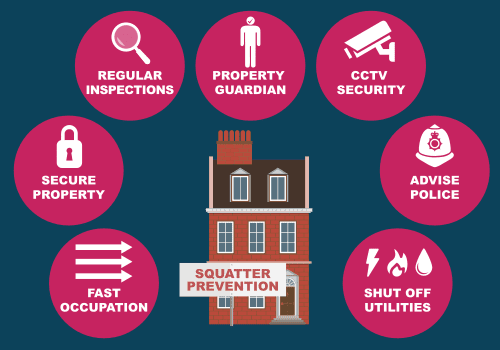Dealing with squatters is a challenge no property owner wants to face. Whether you’ve inherited a vacant property, own rental units, or recently bought a new home, discovering unauthorized occupants can be both frustrating and legally complicated and requires some assistance and negotiation.
Luckily, there are creative, respectful, and effective ways to handle the situation that avoid escalation and promote long-term solutions.
This guide breaks down the essential steps for identifying squatters, navigating the legal documentation system, and using both direct and creative approaches to reclaim your property.
Whether you’re a new homeowner or a real estate investor, this article provides the knowledge and advice you need to act quickly and effectively to avoid conflict.
Quick Summary
This article provides a comprehensive guide to effectively and legally removing squatters from your property. It begins by explaining how to identify squatters and distinguish them from lawful tenants. Once identified, it emphasizes understanding local squatter laws, documenting all evidence, and following the legal eviction process.
Communication strategies can defuse tension, while offering financial incentives or temporary housing can lead to peaceful resolutions. Involving local authorities, when necessary, is discussed as a legal option, especially in cases of trespassing or danger.
For more complex cases, mediation can help resolve disputes without court battles. The article also highlights the value of community support and encourages working with neighbors and local organizations.
After successful removal, property security becomes essential. From changing locks to installing surveillance, proactive measures prevent reentry. Finally, long-term strategies like routine checks, hiring property managers, and using signage are key to keeping your property secure in the future.
Whether you’re facing your first squatter or looking to safeguard your real estate investments, this article equips you with practical tools and creative, legally-sound solutions.
Understanding the Squatter Situation
What Is a Squatter?
A squatter is someone who occupies property without legal permission from the owner or landlord. Unlike a trespasser who may stay temporarily, squatters often reside in a space for an extended period, sometimes even attempting to claim legal rights under adverse possession laws. These laws vary by state and can complicate the removal process if not handled early.
Why Do People Squat?
The reasons can vary. Some are individuals facing homelessness or financial hardship. Others might be opportunists taking advantage of abandoned or neglected properties. Understanding their motivations helps inform your next steps and choose the best removal strategy.
Identifying Squatters
Spotting the Signs Early
Catching squatters early can make all the difference. Watch for these red flags:
- Unfamiliar individuals staying at your property
- Changes to locks or signs of forced entry
- Utility usage without your permission
- Mail or packages addressed to unknown names
Confirming Squatter Status
Make sure you differentiate squatters from tenants. Some might claim a verbal agreement or say they’re staying with a friend. Document everything: take pictures, note conversations, and gather any evidence that shows they lack a legitimate lease.
Legal Considerations
Know Your Local Laws
Squatter laws vary by state. In some places, if a squatter stays long enough and meets certain conditions, they could eventually gain legal rights. Contact a real estate attorney to get clear guidance based on your location.
Start with a Formal Eviction Notice
Even though they’re not legal tenants, the law still requires you to go through a formal eviction process in most areas. This often starts with a written notice to vacate. If they ignore it, you’ll need to file for eviction in court.
Avoid Illegal Tactics
It’s tempting to take matters into your own hands, but changing the locks or shutting off utilities can get you into legal trouble. Always follow the law to avoid prolonging the situation.
Communication Strategies
Speak Calmly and Clearly
A respectful conversation can sometimes defuse the situation. Politely explain that they are on private property and must vacate. Be firm but non-confrontational.
Document All Interactions
Whether you’re talking in person, over the phone, or via written notes, always keep a record of communication. This can help support your case if legal action becomes necessary.
Offering Financial Incentives
Cash for Keys
It may seem counterintuitive, but offering money for the squatter to leave voluntarily can save time and legal fees. This approach, known as “cash for keys,” works well if you’re looking for a peaceful and fast resolution.
Set Terms in Writing
If you go this route, make sure everything is documented. Have the squatter sign an agreement stating they’ll vacate the property by a specific date in exchange for a set payment.
Providing Temporary Housing Solutions
Partnering with Social Services
In cases where the squatters are genuinely in need, helping them find temporary housing or connecting them with local charities can speed up the removal process and show goodwill.
Why It Helps
Offering support creates a path for cooperation rather than resistance. It can be especially effective with families or vulnerable individuals.
Involving Local Authorities
Police Can Help with Trespassers
If you have proof the squatters never had permission to be there, call the police. In many areas, officers can remove individuals on the grounds of trespassing.
When to Call Law Enforcement
Use this approach when you believe there is immediate danger, illegal activity, or if your property is being vandalized or damaged.
Utilizing Mediation Services
Neutral Third Parties
Mediation involves a third-party professional helping both sides reach an agreement. This method is especially useful when the squatter believes they have a right to stay.
When Mediation Works
If direct communication breaks down but you want to avoid court, mediation offers a lower-cost and often faster alternative.
Engaging Community Support
Talk to Neighbors
Let neighbors know about the situation. They might provide helpful information about who’s coming and going or if suspicious activity is happening.
Use Local Advocacy Groups
Some community organizations offer resources for both property owners and squatters. These groups can act as intermediaries to help resolve the situation peacefully.
Changing Locks and Securing Property
Only After Legal Clearance
Once the squatter leaves, and you have legal authority, change all locks immediately. Consider upgrading to smart locks or keypad entry for added control.
Secure All Entry Points
Install motion-sensor lights, security cameras, and strong window locks. If your property is vacant, board up vulnerable areas and make it look lived-in to deter future squatting.
Long-Term Prevention Strategies
Regular Property Checks
Visit your property often, especially if it’s vacant. Regular inspections reduce the risk of squatters establishing residency unnoticed.
Hire Property Managers
If you own multiple properties or live far away, hiring a local property manager can give you peace of mind and fast response if issues arise.
Use “No Trespassing” Signs
Posting clear signage shows that the property is actively monitored and legally protected. It also helps build your case if someone does squat.





